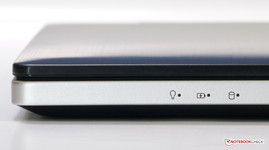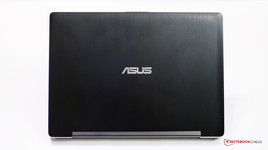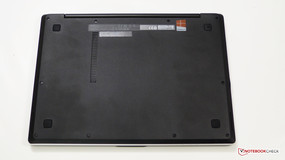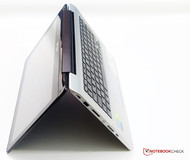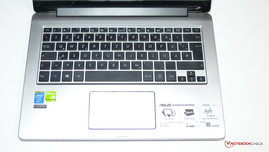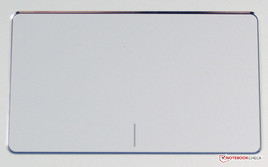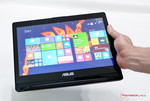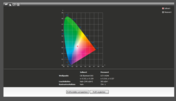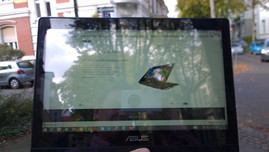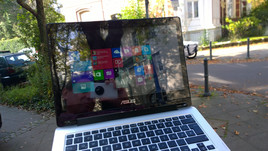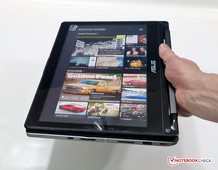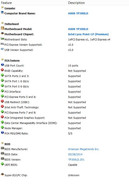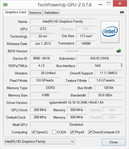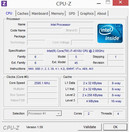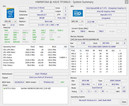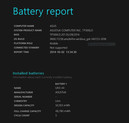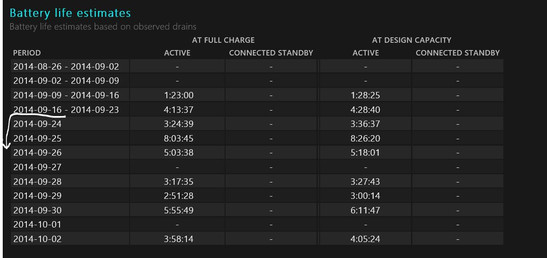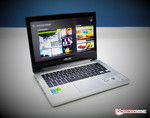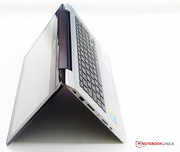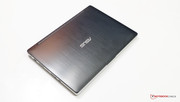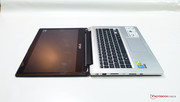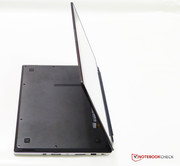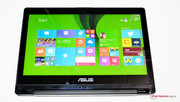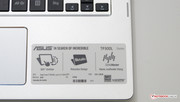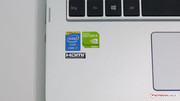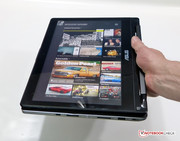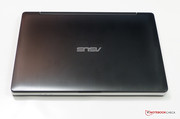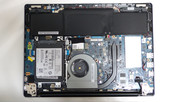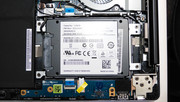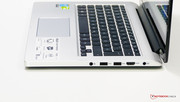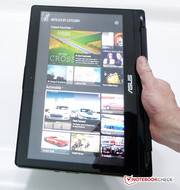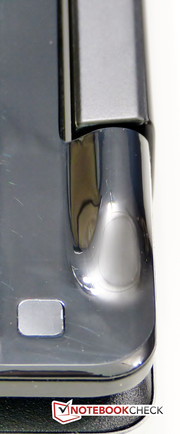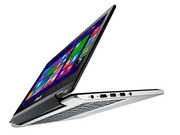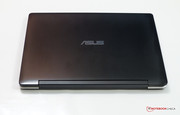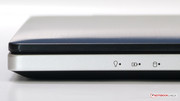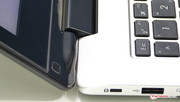Asus Transformer Book Flip TP300LD-C4031H Convertible Review

The ASUS Transfomer Book Flip TP300L was revealed in May 2014 and comes in two main versions. The TP300LA is a Core i5 version with HD4400 graphics. The TP300LD (being reviewed here) bumps the specifications up to include the Nvidia GeForce 820M graphics card. Within those two product ranges lie different screen resolutions (1366x768 and 1920x1080), different storage options and different CPU options. There's a TP500, 15.6-inch version on the market too. As the name suggests this is a 2-in-1 laptop with a fold-back touchscreen. Stand, easel and tablet modes are possible but there's no digitizer layer on any version. The TP300L doesn't aim to be the lightest laptop on the market but the reason for that will become clear.
The ASUS TP300L is a direct competitor to the Lenovo Yoga Pro 2 and we'll be looking closely at that comparison as we go through the review.
Stand-out features include...
- 360-degree folding touchscreen
- Nvidia Geforce 820M GPU
- Core i7, 8GB RAM, 128GB SSD
- SonicMaster Speakers
- Full HD IPS screen
- Premium design
- WiFi AC support
Case
At 1.75 Kg / 3.85 pounds the ASUS Transformer Book Flip TP300L isn't a lightweight 13.3-inch laptop but it's a well-built, solid and, according to ASUS, 'robust' design. Build quality seems to be excellent with very little flex or noise although the screen, perhaps because of its metallic back and touchscreen, wobbles on it's hinge when using the touchscreen. The materials feel good and give the owner some confidence that this isn't just a laptop for 2-years but for 3,4 or more. ASUS are promoting long-life batteries in the T300L so the sealed-in battery might not be a disadvantage over that period of time. The rear can be removed but it's going to void the warranty and require a little skill with the screwdriver and a separating tool.
Port positioning is focused onto the right side of the unit where two USB 3.0 ports, a full-size HDMI, power and headset port are located. On the other side you'll find a full size SD card slot, USB 2.0 port and Kensignton lock port. The volume rocker Windows button and power button are also located on the side which allows those controls to be used in tablet mode. In practice we didn't use tablet mode much and found ourselves accidentally turning the Transformer Book Flip off when lifting it between locations. Luckily the start-up speed is fast and reliable.
The ASUS Transformer Book Flip isn't what we would call rugged but it looks to be build to a higher standard than normal.
Connectivity
Two USB 3.0 ports, a USB 2.0 port, full size HDMI and full-size SD card slot cover the basics but we would have liked to have seen a Gigabit Ethernet port as this is a powerful enough laptop to be a desktop. We forgot to bring our Gigabit Ethernet USB adapter on one occasion and had to fall back onto a less-than impressive local hotspot. AC WiFi might be supported on the Intel AC-7260 WiFi card but it's not always available.
Also missing from the port selection is a sleep and charge USB capability. This is again something we tried to use in earnest when caught out with an empty smartphone.
A single microphone is located in the screen frame, two speakers are found on the underside and three indicator lights can be found on the front edge of the TP300L.
Communication
A dual-band Intel AC-7260 wireless card provides WiFi connectivity and Bluetooth services up to 867 Mbps if the wireless router supports it. In practice we saw average wireless performance in our normal working environment with a few occasions when we we unable to connect to our 2.4ghz 802.11n hotspot. In another environment we confirmed 40Mhz channel operation in the 2.4Ghz band with the 802.11n protocol and saw the TP300L slightly beating a Surface Pro 3 in a speed test.
There's no 3G/4G option on the TP300L, no NFC, no compass and no GPS. A basic orientation and accelerometer sensor set are included.
Security
No special security features are included in the ASUS TP300L and that includes the ommision of a TPM module. Given that there isn't a VPro or Windows 8.1 Pro version available this is to be expected.
Accessories
The power adapter is a 'wall blister' unit with a long, light and flexible power cable. The unit is quite large though and this will be due to the peak requirements of the platform and its two graphics cards. The PSU rating is 19V and 3.42A (65 watts.)
Warranty
Warranty will depend on geographic location. Our model, supplied from Germany, came with the standard 2-year warranty.
Input Devices
Keyboard
As we write this review on the ASUS Transformer Book TP300L we're very happy with the keyboard which has a solid feel with good haptics, a reasonable level of travel and minimal noise. Note that there is no backlight on this keyboard which is something we were expecting on this premium-looking build. The white-on-black key markings work well enough in normal light so it's only in very low-light situations that you'll be missing the backlight. Function keys are not reversed. Screen brightness/backlight off, external display selection, trackpad lock and volume controls are available through the function row.
Touchpad
A large, attractive touchpad includes integrated mouse buttons and multi-touch capability. The mouse clicks require high pressure, are loud and definite but given that touch-to-click and a two-finger tap to right-click is available you've got the best of both worlds. The touchpad is responsive and we haven't seen any mouse-jumping or experienced any issues at all in out two weeks of testing.
Touchscreen
The 10-point touchscreen seems responsive right into the corners. We opted to use a 125% windows font/sizing boost on the desktop and although we encountered some hard-to-read small-font websites, pinch to zoom was responsive enough to become a natural response. There's no digitizer layer on the TP300L screen which is a shame given the tablet and easel modes available.
Display
We have the 1920x1080 resolution screen on this review device and on first impressions it looks like a performer! IPS viewing angles, punchy colors and a very high brightness mean there's little worry about extreme usage scenarios. Auto-brightness seems to be well tuned too. A glossy screen, expected on this class of touch laptop, can create distracting reflections in some situations.
The hinge appears to be strong and there's no tip-back point when opening the display.
Brightness details are shown below and the figures, all well over 300 nits, are good.
| |||||||||||||||||||||||||
Brightness Distribution: 93 %
Center on Battery: 345 cd/m²
Contrast: 734:1 (Black: 0.47 cd/m²)
ΔE ColorChecker Calman: 4.82 | ∀{0.5-29.43 Ø4.77}
ΔE Greyscale Calman: 4.97 | ∀{0.09-98 Ø5}
64% AdobeRGB 1998 (Argyll 1.6.3 3D)
72.6% AdobeRGB 1998 (Argyll 3D)
98.9% sRGB (Argyll 3D)
74.4% Display P3 (Argyll 3D)
Gamma: 2.35
CCT: 6435 K
The display panel returned good figures in our testing. Contrast ratio is 734:1 with a very good 345 cd/m2 center brightness figure and good brightness distribution.
Colors are quite good with a delta figure of 4.97. Gray scale representation has a deltaE 2000 of 4.97. The screen provides 64 percent coverage of Adobe RGB 1998. While this may not be the ultimate graphic artists screen it does represent good quality for the price.
Built-in adaptive brightness appears to work well and does not 'hunt' at lower light levels.
With a max brightness of 345 nits (center, mains or battery power,) strong color and dynamic range the TP300L is well suited to bright light environments. Outdoor use is also possible but the glossy finish limits it to areas where the screen is reflecting dark or shady areas. The images below show the typical reflection problems associated with glossy screens.
The IPS screen privodes acceptable viewing angles which are suitable for multi-user viewing and close-range tablet usage in portrait or landscape mode. The images are taken with fixed camera settings. In real life the eye adjusts to compensate.
Performance
The ASUS Transformer Book Flip TP300L with the Core i7, 8GB of RAM and the Nvidia GeForce 820M offers an exciting level of potential performance but it should be noted that this laptops performance is still in the Ultrabook class and therefore only has a dual-core U-series CPU. This is not a platform to be doing CPU-bound video rendering on. Having said that the performance is easily enough for desktop usage for office, medium-complexity photo editing and 1080p home video editing. It's at the top of the range when it comes to Ultrabook-class performance. As for gaming, the 820M is not a hugely powerful discreet GPU and although it brings advantages that might make the difference between 'playable' and 'not playable' this is not a worry-free gaming setup. Versions of the TP300L with Core i3, Core i5 and without the 820M will obviously has lower levels of performance. It's possible to get more performance in this weight category though so users that are looking for something with higher performance may have to drop the touch and 'flip' design for a more traditional laptop option.
Processor
The Intel Core i7-4510U is a dual-core SoC with hyperthreading that can Turbo Boost up to 3.1Ghz with a single core or 2.8Ghz in dual-core operation. The built-in graphics unit is the HD4400 which clocks up to 1.1Ghz. Quick-sync, Clear Video HD Technology and WiDi are supported.
The Cinebench CPU scores we measured are up at the top-end of what we've seen on U-series 4th generation Core (Haswell) processors and it appears that there's enough thermal headroom to support long-duration Turbo Boost operations. Under battery saving mode the unit is clocked down and locked to the minimum 800Mhz rate. Note that full performance is also available under battery operation.
System Performance
PCMark 7 confirmed our first impressions that the system is free of any major bottlenecks. In fact the SSD performance is very impressive with an especially good 4K write speed. For browser usage the system again performs very well with single-threaded Sunspider 1.0.2 scores almost breaking into two-figure territory. (109ms)
For browser usage one can expect fluid resposne in all browser applications although there are limits. A HTML5 test using the Microsoft fishbowl demo was returning a maximum 33 fps with 500 fish.
| PCMark 7 Score | 4976 points | |
Help | ||
Storage Devices
The Sandisk 128GB SSD has great all-round performance with a stand-out figure of around 90 MB/s in the 4K size write tests. The SSD is a SATA-connected drive and therefore upgradable if the user is prepared to remove the back of the TP300L and void the warranty. Disk encryption is not provided as it is on some small-screen Windows tablets. See images of the TP300L with the rear casing removed in the right column on this page.
| CrystalDiskMark 3.0 - Write 4k (sort by value) | |
| Asus Transformer Book Flip TP300LD-C4031H | |
| Lenovo Yoga 2 Pro | |
| Microsoft Surface Pro 3 | |
Graphics Solution
The HD4400 built-in graphics are clocked up to 1.1Ghz which results in some of the best performance you'll see from the on-chip GPU. The performance is so good that we struggled to find benchmarks that show the Nvidia Geforce 820M discreet card as having much of an advantage. Indeed, in some tests the Geforce 820M under-performed the HD4400. The issue of compatibility and optimization may play a role for some games but in our tests we didn't see any performance scores that led us to believe we were getting a huge boost in gaming frame rates. Still, there is enough here to push game frame rates up which could be important for some.
Full GPU performance appears to be available in battery mode, at least for our short-term tests and there's very little, if any throttling detectable in medium-term tests.
| 3DMark 06 Standard Score | 6362 points | |
| 3DMark 11 Performance | 1410 points | |
Help | ||
| 3DMark 11 - 1280x720 Performance (sort by value) | |
| Asus Transformer Book Flip TP300LD-C4031H | |
| Microsoft Surface Pro 3 | |
| Lenovo Yoga 2 Pro | |
Gaming Performance
Gaming performance is not barrier-free. You'll need to choose game settings carefully and some very recent graphics-intensive games may not function well at all. We took WoW and Diablo III and tested frame rates at various settings with both graphics cards.
In both games, using the Nvidia Geforce 820M we were ale to get good frame rates up to high settings. In Full HD mode with high settings the frame rates dropped considerably with World of Warcraft becoming unplayable. Switching to the HD4400 in WoW saw the frame rate in our Ultra test drop from 17 to 12 fps giving the Geforce a 41% advantage over the HD4400. In other cases the differential wasn't so great.
We were unable to select the HD4400 GPU for the Diable III test.
Under battery power we saw no degradation in performance.
Airflow noise was obvious during game testing, battery life drops very quickly and, naturally, heat levels rise.
Based on the game performance results and other 3D graphics testing we would not recommend the TP300L as a gaming laptop but there's considerable scope here for some short-term gaming fun on battery which could appeal to many. Combined with the bright and sharp screen and the good speakers the TP300L could also provide enough gaming satisfaction as a bedroom PC.
| low | med. | high | ultra | |
|---|---|---|---|---|
| World of Warcraft (2005) | 94 | 44 | 41 | 12 |
| Diablo III (2012) | 95 | 63 | 51 | 31 |
Emissions
System Noise
In a silent environment the fan is nearly always audible but it's a very gentle noise and not something that would annoy anyone. Under load, too, it's an acceptable noise level without any serious mechanical noise or hum. It is possible to make the TP300L silent by switching to low-power mode, disabling the GT820M thought the Nvidia software, reducing screen brightness and doing very low-end operations. For example, typing in a spreadsheet. It's not possible to have silent operation when using the browser.
Noise level
| Idle |
| 32 / 32.3 / 32.9 dB(A) |
| Load |
| 40.7 / 43.2 dB(A) |
 | ||
30 dB silent 40 dB(A) audible 50 dB(A) loud |
||
min: | ||
Temperature
In a stress test we were able to detect build-up of temperature on the casing but even after 10 minutes of running a graphics benchmark there was nothing to be concerned about and temperatures never rose bout 50 degrees. The fan heat exits up from the back of the base unit and in front of the screen in laptop mode and seems to be well designed.
(±) The maximum temperature on the upper side is 42.7 °C / 109 F, compared to the average of 35.4 °C / 96 F, ranging from 19.6 to 60 °C for the class Convertible.
(-) The bottom heats up to a maximum of 45.6 °C / 114 F, compared to the average of 36.8 °C / 98 F
(+) In idle usage, the average temperature for the upper side is 26.3 °C / 79 F, compared to the device average of 30.3 °C / 87 F.
(+) The palmrests and touchpad are cooler than skin temperature with a maximum of 31.2 °C / 88.2 F and are therefore cool to the touch.
(-) The average temperature of the palmrest area of similar devices was 27.9 °C / 82.2 F (-3.3 °C / -6 F).
Speakers
Speaker quality is good with a well-rounded, comfortable sound. Naturally there's little bass here. We found the best audio experience in stand mode where the speakers are firing up at the rear of the unit.
HDMI, Miracast and Bluetooth offer digital audio output possibilities and the analogue headphone port is also available.
Energy Management
Power Consumption
Power consumption at the wall socket is as expected given the battery drain figures we were seeing. The PSU is rated at 65W which allows for maximum usage and concurrent charging. Battery life and power-drain figures are analysed in the section below.
| Off / Standby | |
| Idle | |
| Load |
|
Key:
min: | |
Battery Life
The ASUS TP300LD-C4031H is a dynamic device when it comes to battery life. We were able to run it idle with screen-off at just 2.0W. While that not be a common scenario it shows that the platform is at least able to idle down to very low levels. The screen can have a huge affect on battery life though and we found that if you're reading a document using high screen brightness you can half the battery life of this laptop. In the test results you'll see that you can browse at around 7.5W power usage with a 150 nit brightness (6hrs 40 minutes.) Given the relatively heavy (to some Ultrabooks, for example) weight this isn't a good score and a quick look at the MacBook Pro shows just how good it can get.
Note that the browsing test was done with Internet Explorer which, on Windows 8.1 with this platform, always gives more efficient browsing results. The same is true of YouTube. In Chrome you'll get 260 minutes of 1080p viewing but in IE11 you'll get about an hour more - 6 hours.
When playing Diablo III we measured an average battery power usae of 33W which brings you about 1.5 hours of gaming. Compare that to the 2.0W idle figure and you can see that that battery life of the TP300L ranges widely.
We observed a tendency for the TP300LD to jump to higher power usage than we've seen on similar platforms and this may be because of the discreet GPU. Using the Nvidia GT820M will always add significant power usage but even with that disabled (in software) we saw lower-than expected battery life for the 50Wh battery. Looking at the "powercfg" results we see that our testing produced an average (projected) battery life of under 3 hours to over 8 hours with an average of around 4.5 hours. Our testing scenarios are quite intense but that figure is a good guideline for busy work-usage on the ASUS Transformer Book TP300LD-C4031H.
The TP300LD-C4031H is not Connected Standby / InstantGo capable.
Verdict
The ASUS Transformer Book Flip TP300L was a pleasure to test and gave us no nasty surprises during the two-week review period. It looks good and, in this Core i7 build, has a great screen and performance. The keyboard was good, it's quiet and battery life was acceptable. Two points need some thought though and the first is weight. At 1.75KG this laptop isn't heavy but there are lighter laptop options with similar performance. The TP300L isn't a normal laptop though; It includes a touch, rotating screen and a discreet graphics card. In that respect only the Lenovo Yoga 2 13 competes and at 1.66KG it isn't a super-light either. For the specifications the ASUS is a better value laptop [our pricing comparison is based on EU availability. US availability is spotty as we write this review.] The second point to consider is the need for the additional GPU. It's possible to buy the TP300L with a Core i5 CPU and without Nvidia GPU. Graphics performance would be less but as the Geforce 820M isn't adding a huge amount to the gaming experience, is it worth having? Local pricing is likely to make the decision for you and in the local market in Europe we're seeing just 100 Euro price premium to upgrade from Core i5 to Core i7 with the additional 820M GPU. We think that's worth it.
The ASUS Transformer Book Flip TP300L will appeal to those who are happy to add a pound / 500 grams of additional weight to get all the additional features of a good convertible laptop. Touchscreen, stand mode (one we'd use in a seat-back and coffee-drinking scenario for sure) and the tablet mode which although not ideal for reading it is good for one-to-one presentation of images, graphics and, given the Miracast feature, touch-enabled cable-free PowerPoint presentations.
The TP300L does offer a level of gaming that other Ultra-book style platforms can't reach and it might be good enough to make it the ideal bedroom PC but it's not a PC that offers a full range of gaming capabilities.
In the touch-enabled, Full-HD, SSD storage laptop category there aren't many low-cost solutions around but as a short-list we'd have the TP300L at the top, the Yoga 2 Pro second and, if you're looking for a straight laptop, the ASUS Zenbook UX302 and of course the Macbook Pro 13.
A keyboard backlight would top the list of improvements that ASUS could make next time round and perhaps there's scope to drop the HD4400 and Geforce 820M for an Intel Iris GPU but we've got few complaints and find the TP300L to be one of the most highly capable 2-in-1's we've tested.


